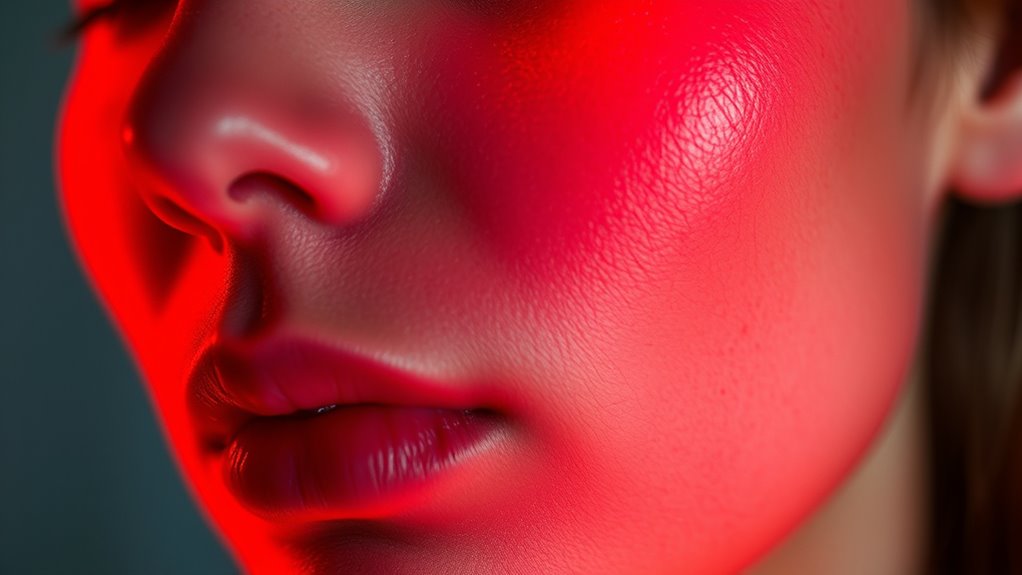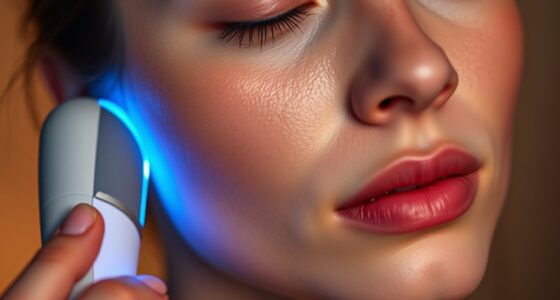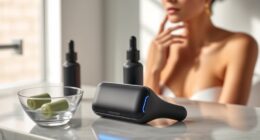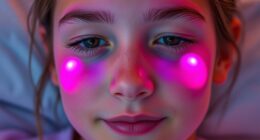Light therapy uses specific wavelengths of light to calm irritated skin and reduce redness effectively. It works by targeting inflamed skin cells, encouraging natural healing, and calming blood vessels responsible for redness. Usually painless and non-invasive, sessions involve gentle light exposure that promotes healing without harsh chemicals. Consistent treatments can bring lasting relief and improve skin clarity. Keep going to discover how you can incorporate this soothing option into your skincare routine for calmer, healthier skin.
Key Takeaways
- Light therapy uses specific wavelengths to target inflamed skin, reducing redness and calming irritation effectively.
- Red and near-infrared light enhance circulation, promoting healing of irritated skin areas.
- Blue light combats bacteria that contribute to redness and skin inflammation.
- Regular sessions help diminish persistent redness and improve skin’s overall calmness.
- Professional guidance ensures personalized treatment plans for safe, effective calming of irritated skin.

Are you tired of dealing with persistent redness on your skin? If so, you’re not alone. Many people struggle with irritated, inflamed skin that seems resistant to traditional treatments. Fortunately, light therapy offers a promising solution for calming and reducing redness. This non-invasive treatment uses specific wavelengths of light to target inflamed skin cells, promote healing, and restore your skin’s natural balance. It’s a gentle approach that can fit easily into your skincare routine without extensive downtime or discomfort.
Light therapy offers a gentle, non-invasive solution to reduce persistent skin redness and promote healing.
When you undergo light therapy for redness, you typically sit comfortably while a device emits controlled beams of light onto your skin. The most common types used are LED (light-emitting diode) therapy and low-level laser therapy. These treatments penetrate the skin at different depths, depending on the wavelength, to stimulate cellular activity and reduce inflammation. Blue light, for example, is effective against bacteria that can worsen redness, making it ideal for conditions like acne or rosacea. Red and near-infrared light, on the other hand, are renowned for their ability to boost circulation, accelerate healing, and soothe irritated tissues. As you relax during the session, you might notice a warming sensation or gentle tingling, but it’s generally painless.
One of the main benefits of light therapy is that it encourages your skin’s natural healing process without the use of harsh chemicals or invasive procedures. It helps calm down the blood vessels that cause persistent flushing and diminishes the appearance of redness over time. Many people notice improvements after just a few sessions, with continued results as your skin responds to the treatment. Additionally, because light therapy targets the root causes of inflammation rather than just masking symptoms, it can lead to more lasting relief. It’s also safe for most skin types and can be customized to suit your specific needs, whether you’re dealing with rosacea, post-acne redness, or general irritation. Incorporating skin treatment innovations such as LED therapy can enhance your overall skincare routine.
Consistency is key with light therapy. You might need a series of treatments scheduled over several weeks to see significant results. Afterward, maintaining your skin’s health with proper skincare and sun protection can prolong the benefits. Keep in mind that while light therapy is effective for many, it’s best to consult a dermatologist or skincare professional to ensure it’s suitable for your skin condition. They can tailor the treatment plan to help you achieve calmer, clearer skin. With patience and regular sessions, you’ll likely find that light therapy can become a valuable part of your journey toward a more even, less irritated complexion.
Frequently Asked Questions
How Long Does It Take to See Results From Light Therapy?
You can typically see noticeable improvements in redness and irritation after 2 to 4 weeks of consistent light therapy sessions. Many people start noticing reduced inflammation and calmer skin within this timeframe. To achieve the best results, follow your treatment plan closely and attend all scheduled sessions. Keep in mind that individual responses vary, so patience and regularity are key to seeing the full benefits.
Are There Any Side Effects Associated With Light Therapy?
Yes, there are some side effects associated with light therapy, but they’re generally mild and temporary. You might experience redness, swelling, or irritation immediately after treatment, which usually subsides quickly. Some people notice dryness or sensitivity, especially if they have sensitive skin. Rarely, there could be burns or changes in pigmentation. To minimize risks, follow your provider’s instructions and inform them of any adverse reactions promptly.
Can Light Therapy Be Used on Sensitive Skin Types?
Yes, light therapy can be used on sensitive skin types, but you should proceed cautiously. Start with shorter sessions and lower intensities to see how your skin reacts. It’s best to consult a dermatologist beforehand, especially if you have conditions like rosacea or eczema. Using gentle wavelengths, like red or near-infrared light, can calm irritation and reduce redness without causing further sensitivity or damage.
Is Light Therapy Suitable for All Ages and Skin Conditions?
Light therapy can be suitable for many ages and skin conditions, but you should consult a dermatologist first. Young children and those with certain skin disorders may need special consideration or alternative treatments. While it’s generally safe, your skin’s unique needs and sensitivities matter. A professional can evaluate your specific situation, ensuring that the therapy benefits you without causing further irritation or adverse effects.
How Does Light Therapy Compare to Topical Treatments?
Light therapy often shows quicker results, with about 70% of users experiencing reduced redness within a few sessions, compared to topical treatments that may take weeks. Unlike creams, light therapy targets deeper skin layers without harsh chemicals. You can enjoy fewer side effects and improved overall skin health. So, if you’re seeking faster, more natural relief, light therapy might be a better choice than topical options.
Conclusion
By incorporating light therapy into your skincare routine, you can effectively soothe redness and calm irritated skin. Think of it as a gentle breeze on a hot day—refreshing and relieving. Remember to be consistent and patient, as results take time. With regular use, you’ll notice your skin becoming calmer and more balanced, helping you regain your confidence. Embrace this calming treatment and let your skin shine with renewed health and tranquility.









